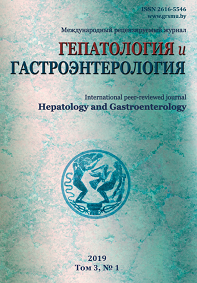THE SIGNIFICANCE OF HIF-1Α, VEGF-A AND INOS IN COLON CARCINOGENESIS
Abstract
Background. Metabolic stress accompanying the development of tumor tissue causes overexpression of hypoxia induced factor (HIF 1α) in cancer cells. This leads to an increase of proangiogenic factors: vascular endothelial growth factor (VEGF) and nitric oxide synthase (NOS). However, data on the prognostic role of a comprehensive assessment of the expression of markers in colorectal tubular adenomas are absent.Objective of the study is to determine the significance of HIF1α, VEGF and iNOS expression in colon carcinogenesis.
Materials and methods. The study included 30 colon tubular adenomas, 33 low-grade adenocarcinomas. Immunohistochemistry was performed using antibodies to HIF 1α, VEGF and iNOS. Marker expression was quantified using the Aperio Image Scope_v9.1.19.1567 computer program. Statistical analysis was performed using STATISTICA 10.0 (SNAXAR207F394425FA-Q) and MedCalc (Version 10).
Results. A key factor in the transformation of tubular adenoma with a high degree of dysplasia into low-grade adenocarcinoma is a high level of HIF1α (> 0.391) (sensitivity 100%, specificity 100%). Malignancy of tubular adenoma with low-grade dysplasia can be expected at VEGF levels> 0.884 (sensitivity 89.3%, specificity 80%) and iNOS≤0.89 (sensitivity 84.8%, specificity 80%).
Conclusion. Low-grade adenocarcinoma development in patients with tubular adenoma with dysplasia of different degrees can be predicted by the levels of VEGF, iNOS and HIF 1α.
References
1. de Jong AE, Morreau H, Nagengast FM, Mathus-Vliegen EM, Kleibeuker JH, Griffioen G, Cats A, Vasen HF. Prevalence of adenomas among young individuals at average risk for colorectal cancer. The American Journal of Gastroentherology. 2005;100(1):139-143. doi:10.1111/j.1572-0241.2005.41000.x.
2. Davies RJ, Miller R, Coleman N. Colorectal cancer screening: prospects for molecular stool analysis. Nature Reviews Cancer. 2005;5(3):199-209. doi:10.1038/nrc1545.
3. Roskelley CD, Bissell MJ. The dominance of the microenvironment in breast and ovarian cancer. Seminars in Cancer Biology. 2002;12(2):97-104. doi:10.1006/scbi.2001.0417.
4. Heddleston JM, Li Z, Lathia JD, Bao S, Hjelmeland AB, Rich JN. Hypoxia inducible factors in cancer stem cells. British Journal of Cancer. 2010;102(5):789-795. doi:10.1038/sj.bjc.6605551.
5. Baish JW, Jain RK. Cancer, angiogenesis and fractals. Nature Medicine. 1998;4(9):984. doi:10.1038/1952.
6. Zhong H, De Marzo AM, Laughner E, Lim M, Hilton DA, Zagzag D, Buechler P, Isaacs WB, Semenza GL, Simons JW. Overexpression of hypoxia-inducible factor 1alpha in common human cancers and their metastases. Cancer Research. 1999;59(22):5830-5835.
7. George ML, Tutton MG, Janssen F, Arnaout A, Abulafi AM, Eccles SA, Swift RI. VEGF-A, VEGF-C, and VEGF-D in colorectal cancer progression. Neoplasia. 2001;3(5):420-427.
8. Vaupel P, Mayer A. Hypoxia in cancer: significance and impact in clinical outcome. Cancer and Metastasis Reviews. 2007;26(2):225-239. doi:10.1007/s10555-007-9055-1.
9. Shtabinskaya TT, Bodnar M, Lyalikov SA, Basinskiy VA, Marshalek A. Prognosticheskoe znachenie urovnja jekspressii faktora rosta jendotelija sosudov v kolorektalnom rake [Assessment of prognostic significance of expression level of vascular endothelial growth factor in colorectal cancer]. Zhurnal Grodnenskogo gosudarstvennogo medicinskogo universiteta [Journal of Grodno State Medical University]. 2015;51(3):64-69. (Russian).


















1.png)






